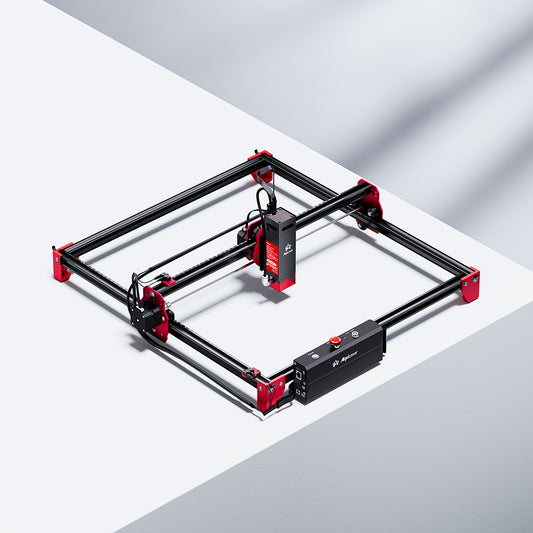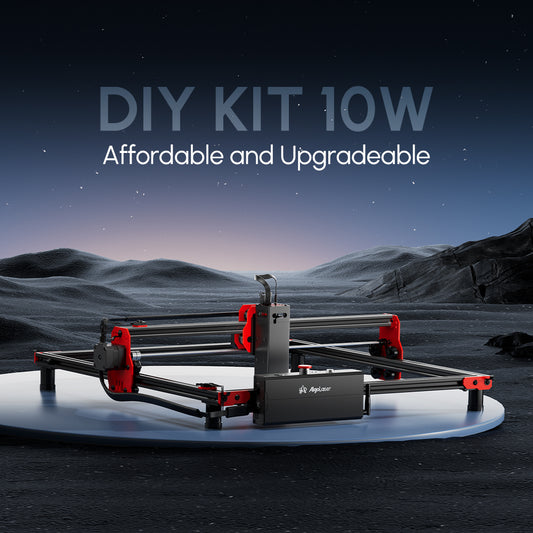How to Use a Laser Engraver for the European Football Championship
Laser engraving has revolutionized the way we customize products, making it possible to create detailed and personalized items with ease. The European Football Championship, being one of the most celebrated sports events in the world, presents a perfect opportunity for businesses and enthusiasts to create unique memorabilia and merchandise. We will guide you through the process of using a diode laser engraver, specifically the AlgoLaser Alpha MK2, to engrave and cut products for the European Football Championship.


Types of Laser Engrave Materials
Understanding the types of materials that can be engraved with a diode laser engraver is crucial for achieving the best results. The materials you choose will determine the settings and techniques you use, as well as the final look of your product.
Wood
Wood is one of the most popular materials for laser engraving due to its versatility and natural aesthetic. Different types of wood, such as maple, cherry, and plywood, react differently to laser engraving. Hardwoods typically produce a more pronounced engraving, while softer woods may require lower power settings.
Acrylic
Acrylic is another commonly used material for laser engraving and cutting. It offers a sleek, modern look and is available in various colors and finishes. Acrylic can be used to create signage, keychains, and decorative items. When laser cutting acrylic, it is essential to use the correct speed and power settings to avoid melting or warping the material.

Metal
While diode lasers are not typically used for deep metal engraving, they can be effective for marking coated metals, such as anodized aluminum. This is ideal for creating custom metal items like dog tags, nameplates, and trophies. For bare metal engraving, fiber lasers are usually more appropriate.
Glass
Engraving on glass creates a frosted appearance that is both elegant and permanent. This technique is perfect for creating custom glassware, such as wine glasses, trophies, and plaques. It is important to use lower power settings and slower speeds to prevent cracking or shattering the glass.
Leather
Leather engraving is ideal for personalized gifts and accessories. Diode lasers can engrave intricate designs on leather items like wallets, belts, and journals. It is essential to ventilate your workspace properly when engraving leather, as it can produce fumes.

Plastics
Various plastics can be engraved and cut with a diode laser engraver. Materials like ABS, polycarbonate, and Delrin are commonly used. Each plastic type has its own set of guidelines for laser engraving and cutting, so it is crucial to refer to the manufacturer’s recommendations.
Paper and Cardboard
For creative and lightweight projects, paper and cardboard are excellent materials for laser engraving. These materials are often used for making custom greeting cards, invitations, and packaging. Lower power settings are typically sufficient for engraving and cutting these materials.
Stone
Stone engraving with a diode laser engraver can produce stunning results, especially on materials like marble, granite, and slate. This technique is often used for creating plaques, coasters, and decorative items. It is important to note that stone engraving can be slow and requires patience.
Summary
Selecting the right material for your laser engraving project is the first step towards achieving professional results. Each material requires specific settings and techniques, so it is essential to experiment and fine-tune your laser engraver to suit the material you are working with.
How To Laser Engrave and Cut by AlgoLaser Alpha MK2
The AlgoLaser Alpha MK2 is a versatile diode laser engraver known for its precision and ease of use. In this section, we will provide a detailed guide on how to use the AlgoLaser Alpha MK2 to engrave and cut materials for products related to the European Football Championship.
Setup and Safety
1. Workspace Preparation: Ensure your workspace is clean and well-ventilated. Set up the engraver on a stable, flat surface.
2. Safety Gear: Wear safety goggles specifically designed for laser use. Ensure that the area around the laser is clear of any flammable materials.
3. Machine Setup: Follow the manufacturer's instructions to assemble and calibrate the AlgoLaser Alpha MK2. Connect it to your computer and install the necessary software and drivers.
Design Preparation
1. Software: Use design software compatible with the AlgoLaser Alpha MK2, such as LightBurn or LaserGRBL. Create or import your design, ensuring it fits the dimensions of your material.
2. Settings: Adjust the laser power, speed, and resolution settings according to the material you are using. Refer to the material’s guidelines or conduct test runs to find the optimal settings.
Engraving Process
1. Material Placement: Secure the material on the engraving bed, ensuring it is flat and stable.
2. Focus the Laser: Adjust the focus of the laser for optimal precision. Most diode lasers have a focus knob or an adjustable lens.
3. Test Run: Conduct a test run on a scrap piece of material to ensure the settings are correct and the design is aligned properly.
4. Engraving: Once satisfied with the test run, proceed with engraving your final piece. Monitor the process to ensure everything runs smoothly.
Cutting Process
1. Design Preparation: In your design software, differentiate between engraving and cutting paths. Typically, cutting paths are represented by different colors or layers.
2. Settings: Adjust the laser power and speed settings for cutting. Cutting typically requires higher power and slower speeds compared to engraving.
3. Material Placement and Focus: Secure the material and adjust the focus as needed.
4. Test Cut: Perform a test cut on a scrap piece to verify the settings.
5. Cutting: Proceed with the cutting process, monitoring the machine closely to ensure accuracy and safety.
Finishing Touches
1. Cleaning: After engraving or cutting, clean the material to remove any residue or debris. Use appropriate cleaning agents for the specific material.
2. Inspection: Inspect the final product for any imperfections. Make any necessary adjustments or touch-ups.

The Best 10 Engraving Products for European Football Championship
Creating custom products for the European Football Championship can be a lucrative venture. Here are the top 10 engraving products that fans and participants will love.
1. Custom Trophies and Medals
Trophies and medals are iconic symbols of achievement in sports. Custom engrave them with team logos, player names, and the event date to create memorable keepsakes.

2. Personalized Keychains
Keychains are practical and highly customizable. Engrave them with team emblems, championship logos, or player names. Materials like metal, wood, and acrylic are excellenlaser engraving to add names, team logos, and motivational quotes to metal or plastic bottles.

3. Engraved Water Bottles
Water bottles are essential for athletes and fans alike. Use laser engraving to add names, team logos, and motivational quotes to metal or plastic bottles.

4. Custom Glassware
Engraved glassware, such as beer mugs, wine glasses, and pint glasses, make excellent souvenirs. The frosted look achieved through laser engraving adds a touch of elegance.

5. Personalized Phone Cases
Phone cases are always in demand. Create custom designs featuring team colors, logos, and players' names. Laser engraving ensures a durable and precise finish.

6. Engraved Coasters
Coasters are both decorative and functional. Engrave them with team logos, stadium images, or championship dates. Materials like wood, stone, and acrylic work well for this purpose.

7. Custom Plaques
Plaques are perfect for commemorating special moments and achievements. Create custom plaques with detailed engravings of game highlights, team rosters, or historical moments.

8. Personalized Leather Accessories
Leather items such as wallets, belts, and bracelets can be personalized with laser engraving. Add player signatures, team logos, or inspirational quotes for a unique touch.

9. Engraved Signage
Create custom signs for fans to display in their homes or at the event. Engrave team slogans, match schedules, or welcome messages on materials like wood or acrylic.

10. Custom Awards and Certificates
Design and engrave custom awards and certificates for players, coaches, and fans. Use high-quality materials like metal, wood, or acrylic to create lasting mementos.

More than 6 FAQs About Laser Engraving
Laser engraving is a fascinating technology, but it often comes with many questions. Here are more than six frequently asked questions about laser engraving, along with detailed answers.
FAQ 1: What is laser engraving?
Laser engraving is a process that uses a focused laser beam to etch or mark the surface of a material. It is commonly used for creating detailed designs, text, and images on various materials, including wood, metal, glass, and plastic.
FAQ 2: How does a diode laser engraver work?
A diode laser engraver works by emitting a concentrated beam of light from a diode. The laser beam is directed onto the material’s surface, where it removes or alters the material to create the desired design. The intensity, speed, and focus of the laser can be adjusted to achieve different effects.
FAQ 3: What materials can I engrave with a diode laser engraver?
Diode laser engravers are versatile and can engrave materials such as wood, acrylic, coated metals, glass, leather, plastics, paper, cardboard, and some stones. However, they are not suitable for engraving bare metals or very hard materials.
FAQ 4: How do I choose the right settings for laser engraving?
The right settings for laser engraving depend on the material and the desired effect. Generally, you need to adjust the laser power, speed, and focus. It is advisable to refer to the material’s guidelines or conduct test runs to determine the optimal settings.
FAQ 5: How can I ensure safety while using a laser engraver?
Safety is paramount when using a laser engraver. Always wear safety goggles designed for laser use, ensure your workspace is well-ventilated, and keep flammable materials away from the laser. Follow the manufacturer’s safety instructions and never leave the machine unattended while it is operating.
FAQ 6: Can I engrave photos with a laser engraver?
Yes, you can engrave photos with a laser engraver. The process involves converting the photo into a format suitable for engraving, such as a high-contrast black and white image. Software like LightBurn or LaserGRBL can help prepare the image for engraving.
FAQ 7: What are some common troubleshooting tips for laser engraving?
Common issues in laser engraving include poor engraving quality, inconsistent results, and machine malfunctions. To troubleshoot, ensure the material is flat and secure, check the laser focus and alignment, clean the laser lens, and adjust the settings as needed. Regular maintenance and calibration of the machine can also help prevent problems.
FAQ 8: How do I maintain my diode laser engraver?
Maintaining your diode laser engraver involves regular cleaning, checking for wear and tear, and ensuring proper calibration. Clean the laser lens and mirrors regularly, lubricate moving parts, and inspect electrical connections. Follow the manufacturer’s maintenance guidelines to prolong the life of your machine.
Summary
Understanding the basics of laser engraving, the capabilities of your diode laser engraver, and how to maintain and troubleshoot it will help you achieve the best results and ensure a safe and efficient operation.

Conclusion
Laser engraving offers a unique way to personalize and enhance products, making them special and memorable. By understanding the capabilities and settings of your laser engraver, you can create high-quality items that appeal to fans and participants of the European Football Championship. Whether you are engraving trophies, keychains, or glassware, the possibilities are endless.





